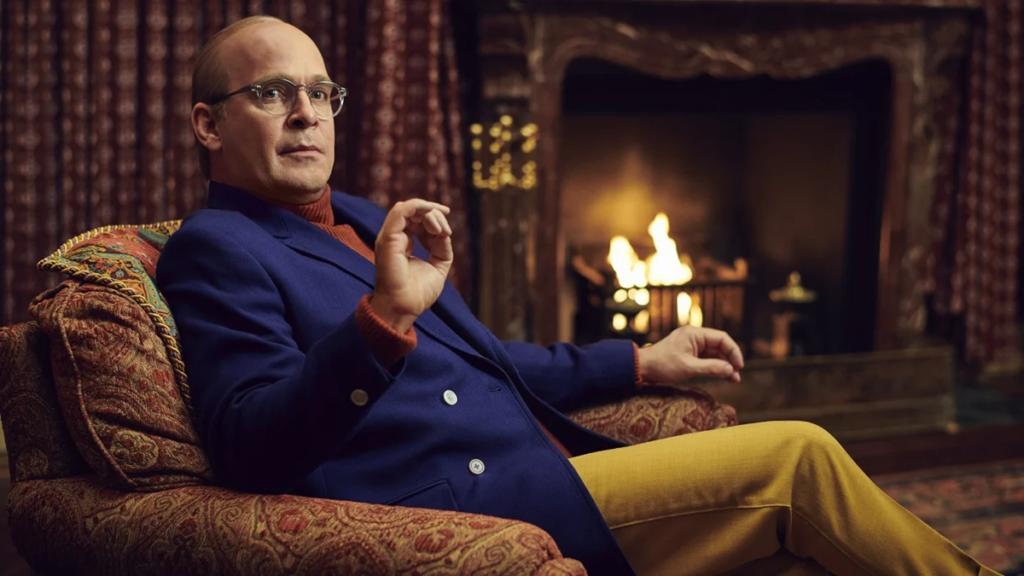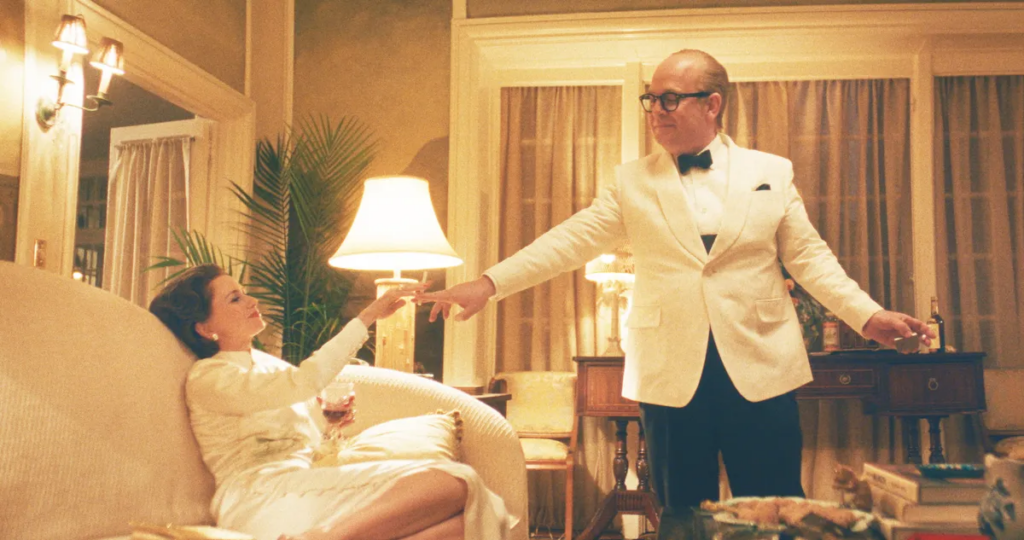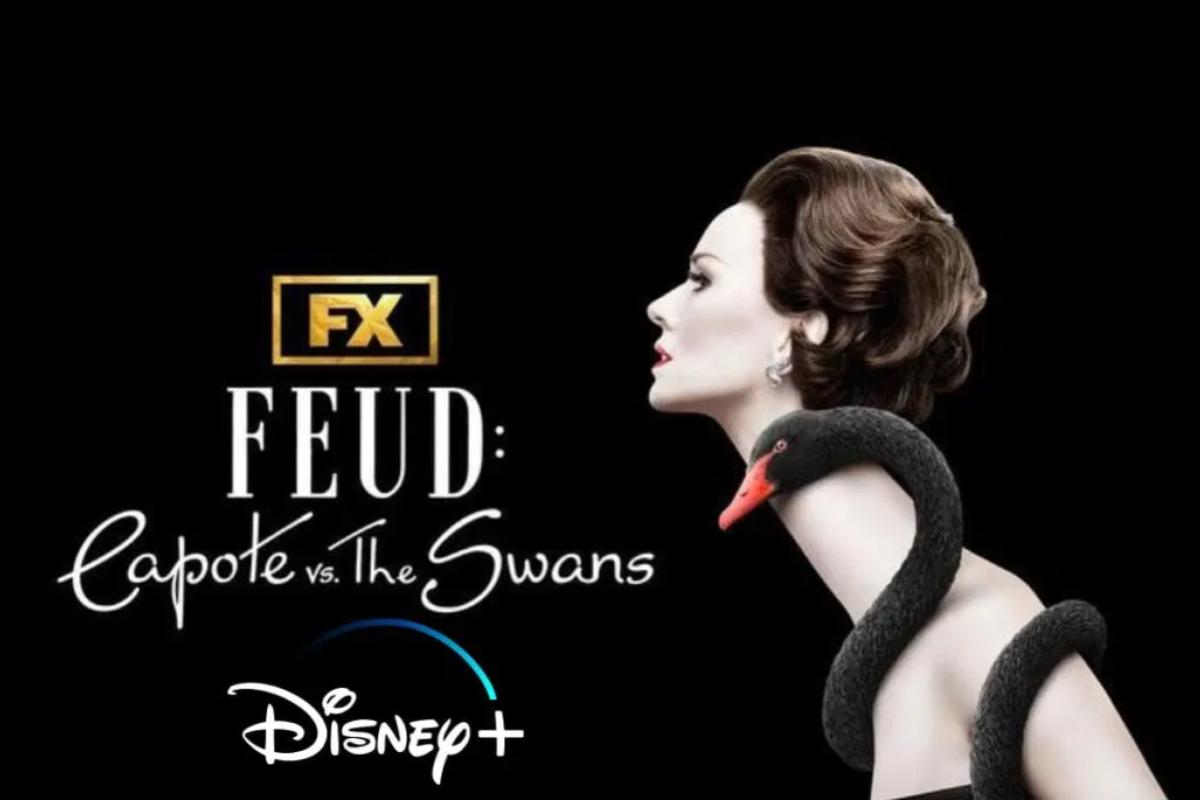We’ve all been there before: Meeting a lavishly charming gay man who fills all the voids our dear fathers left. He’s an often-extravagant man who listens and gives us access to an unaggressive intimacy with the opposite sex – and we’re sold. We spiritually marry them and open our hearts and souls without looking at the price tag, a misstep we most probably will come to regret, more or less how the gorgeous 1960s New York socialites called The Swans regretted serving their privacy to Truman Capote on a silver platter. This is the argument of Feud: Capote vs. The Swans, the second season of the anthology television series Feud by Ryan Murphy. The eight-episode season is based on the book Capote’s Women: A True Story of Love, Betrayal, and a Swan Song for an Era written by Laurence Leamer, a story that, while implausible for the ordinary person outside wealthy social circles, does portray a feminine struggle we all know very well.
The Swan’s Mask of Elegance

“Beautiful and unruffled above the waters, stunning, singular, gliding through the ponds of society,” Capote describes the Fifth Avenue Swans, Babe Paley, Slim Keith, Lee Radziwill, and C.Z. Guest, in the series’ first episode. “But God gave them too much baggage, you see. Underneath the crisp surface of the water, they have to paddle twice as fast and vigorously as an ordinary duck just to stay afloat.”
“It’s a great burden only some can bear,” he adds admiringly.
Tom Hollander’s performance as the famous writer and actor in Feud: Capote vs. the Swans is both impeccable and unsettling. It leaves the audience with the bitter taste of a self-conscious man carrying a Freudian ghost underneath his cashmere sweater. He is a once-successful writer determined to trade any affection for the feeling of belonging to a high society from which his mother was rejected.
However, the true masterpiece of the series is, undoubtedly, The Swans.
In 1965 New York, everything happened around a small group of women. Babe Paley, a former Vogue fashion editor; C.Z. Guest, a fashion icon who married into the wealthy Churchill/Guest family; Slim Keith, who married film director Howard Hawks; Ann Woodward, a radio actress who married banker William Woodward Jr, and Lee Radziwill, Jackie Kennedy’s younger sister.
Bringing those characters to the 21st century is no easy feat—unless you cast Naomi Watts, Diane Lane, Chloë Sevigny, Calista Flockhart, and Demi Moore. Beyond being brilliant actresses, these women embodied the elegance of a decade, wearing Givenchy, Norman Norrell, and Halston just to leave the house.
However, beyond a perfect sense of style and fashion, these women had another thing in common – Truman Capote.
Capote and the Intricacies of Ambition

Truman Capote was born in 1924 in New Orleans, Louisiana. He was an avid reader and writer since a young age, and by the time he moved to New York to live with his mother and her second husband, José García Capote, he had already received recognition for his writing. But his family fell from grace after his stepfather was convicted of embezzlement, and leaving their home on Park Avenue was a humiliation neither Truman nor his mother could ever shake.
Imagine being a 5′ 3″ gay man with a severe inferiority complex suddenly climbing the rungs of high society to listen to the intimacies of women like C.Z. Guest, cover girl and muse to Andy Warhol and Salvador Dalí, whose best man at her wedding was Ernest Hemingway.
Now, imagine being married to CBS Founder William Paley, as Babe Paley was, and having to deal with the scandalous infidelities of your husband while keeping a façade of perfection and having no one to confide in.
It was a match made in heaven for the perfect feud.
Friendship and Betrayal

“If you are a strong, intelligent woman in this world, you have two options,” says Slim (Diane Lane) to the videographer recording the preamble to Capote’s grand event in episode three. “You can dumb yourself down, which I refuse to do, or you can accept that you will always be fundamentally alone.”
In Feud: Capote vs. The Swans, Babe Paley (Naomi Watts) embodies the neurotic need for perfection in a profoundly flawed life. From original impressionist paintings in the living room to every single outfit, Babe Paley was doing it all right. Her only flaw was that she was Truman Capote’s best friend.
Their codependent relationship was based on Babe’s need for Truman’s constant support and and his need to be of use to a perfect woman in exchange for access to her set.
Capote replicated this formula, though to a lesser degree, with the other Swans. He knew of Slim Keith’s hunt for “a suitable extra man” outside her marriage. Truman knew of Lee Radziwill’s resentment towards her sister, Jackie Kennedy. And he also knew Ann Woodward’s deepest fear was total rejection.
This is why, when faced with writer’s block, the famous writer turned to the intimacies of his so-called best friends – and many bottles of vodka – to write his next bestseller. He sold the first pages of the manuscript he titled “Answered Prayers” to Esquire Magazine between 1975 and 1976. The famous “La Cote Basque” column not only provoked Capote’s social suicide but drove Ann Woodward to take her own life in her Fifth Avenue apartment.
Coming to Terms with Life, Post-Mortem

As often happens with nuanced characters like Truman Capote, a lifetime is not enough to tell all the stories and confess all the truths. Before meeting his foretold death at the end of a vodka bottle, he had to come to terms with all his ghosts – Babe included.
The priest who gave him his last confession was none other than James Baldwin, portrayed in Feud: Capote vs. the Swans by Chris Chalk. While strolling through New York, from La Côte to the Met to an underground gay bar, both Capote and Baldwin showed their contempt for a society that didn’t accept gay men – much less if you were Black – and that forced them to use their words and literary talent to show the so-called high class their time was almost up.
Capote admits to the tedious, two-dimensional nature of the social circle he wanted so much to belong to. He recognizes the homophobia, the racism, and the inadequacy of societal dynamics like The Swans.
And he was preaching to the choir.
“Your book, it is the firing squad that killed the Romanovs,” Baldwin tells Capote why his masterpiece needed to be completed. “It’s your guillotine that beheaded Marie Antoinette.”
However, by then, Babe is gone, the other Swans are slowly returning to their dull lives, and even La Côte Basque is closing. All that is left is Capote’s delirious need for forgiveness amid an alcohol withdrawal.
He tries to change the plot of “Answered Prayers” to a fix-all narrative in which he regains the love of the remaining Swans, only to have the hallucinated ghost of his mother come to haunt him. Even Ann Woodward (Demi Moore) appears to tell him there is no forgiveness and that he should give up.
And so he did, but not before burning the manuscript and diving – both literally and metaphorically – into a pool of vodka and yellow notepads. A perfect ending for a persona whose only dignity came from the love of strong and deeply flawed women whom he betrayed.

